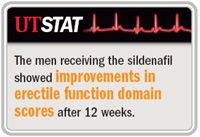Article
PDE-5 inhibitors show efficacy in ED and LUTS
Author(s):
Atlanta-Sometimes studies are more notable for the questions they raise than for the ones they answer. Kevin T. McVary, MD, professor of urology at Northwestern University Feinberg School of Medicine, Chicago, presented a study at the AUA annual meeting showing that the phosphodiesterase type-5 inhibitor sildenafil citrate (Viagra) improves both erectile function and lower urinary tract symptoms, but has no apparent effect on flow rates.

Dr. McVary's study was one of three presented here showing that PDE-5 inhibitors improved LUTS.

Dr. McVary directed a 12-week, double-blind, placebo-controlled study of sildenafil in 366 men age 45 years and older who scored ≤25 on the Erectile Function domain of the International Index of Erectile Function (IIEF), had an International Prostate Symptom Score (IPSS) ≥12, and PSAs of ≤ 10.0 ng/mL. The men were instructed to take sildenafil, 50 mg, or placebo each night at bedtime or 30 to 60 minutes before sexual activity. After 2 weeks, the dose was titrated to 100 mg with the option of returning to 50 mg if the higher dose was not well tolerated.
Several parameters improve
At 12 weeks, the men receiving the sildenafil showed improvements in EF domain scores. Irritative and obstructive subscores on the IPSS were significantly reduced. The drug also significantly reduced the impact of LUTS as assessed by the IPSS quality of life question. As noted, flow rates did not improve.
Dr. Roehrborn conducted a similar study with tadalafil in 281 men with moderate to severe LUTS secondary to BPH. His 12-week, randomized, double-blind, placebo-controlled, dose-escalation study showed the agent improved sexual function, urinary symptoms, and quality of life. As was seen in Dr. McVary's study, there was no change in flow rates.
In Dr. Kaplan's study, patients with LUTS received alfuzosin, 10 mg/day, sildenafil, 20 mg/day, or a combination of the two agents. The combination treatment netted the best results in all parameters measured, and, unlike the monotherapies in the previous studies, improvements were seen in flow rates.
Dr. McVary called the effect of PDE-5 inhibitor therapy on LUTS "confounding."
"These men improve their symptoms, but their flow rates do not improve. The initial hypothesis was that if PDE-5 inhibitors acted on nitric oxide in the prostate-the prostate is a rich site of nitric oxide synthase and nitric oxide-then their symptoms should improve and the flow rate should increase as it does when alpha-blockers are administered. The symptoms improved markedly, akin to the levels seen with alpha-blockers, but patients' flow rates did not change. No matter which way the data was sliced, the flow rates did not change," said Dr. McVary.





